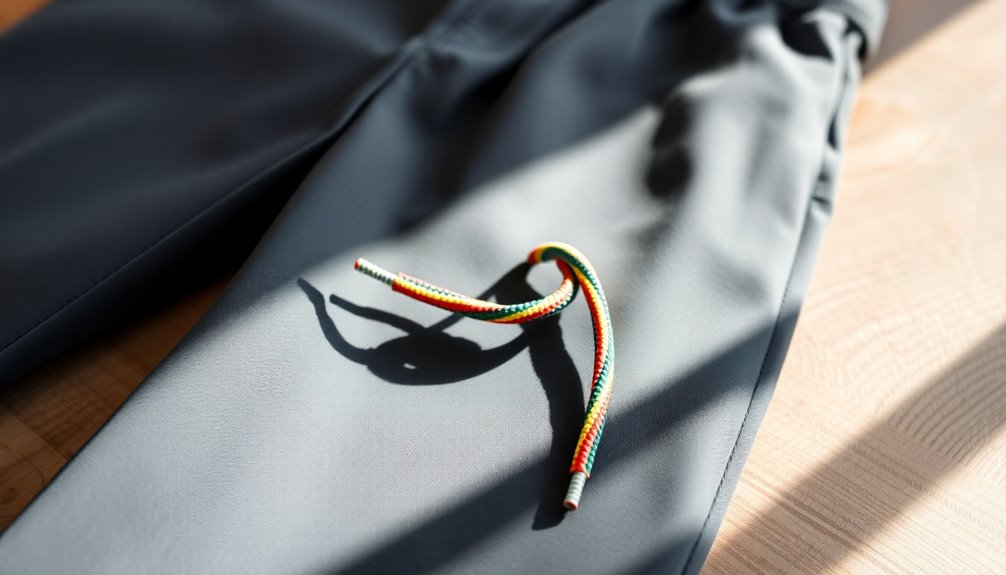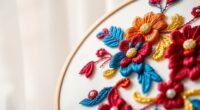To securely attach a drawstring to your pants, start with quality materials like medium weight linen for durability. Create a sturdy casing by reinforcing buttonholes or using grommets for a professional look. Use a safety pin to easily thread the drawstring through. Ascertain the length accommodates your waistband for a comfortable fit. Don't forget to explore customization options, like decorative ends or contrasting fabrics, to make your drawstring unique. There's more innovative tips ahead!
Key Takeaways
- Use a sturdy fabric like medium weight linen for durability when attaching the drawstring to pants.
- Reinforce buttonholes or use grommets to securely anchor the drawstring for added strength.
- Opt for a safety pin to simplify threading the drawstring through the waistband casing.
- Ensure the drawstring length matches the waistband measurement to prevent twisting and uneven gathers.
- Experiment with decorative elements like beads or cord stops to enhance both functionality and aesthetics.
Understanding Drawstring Waistbands
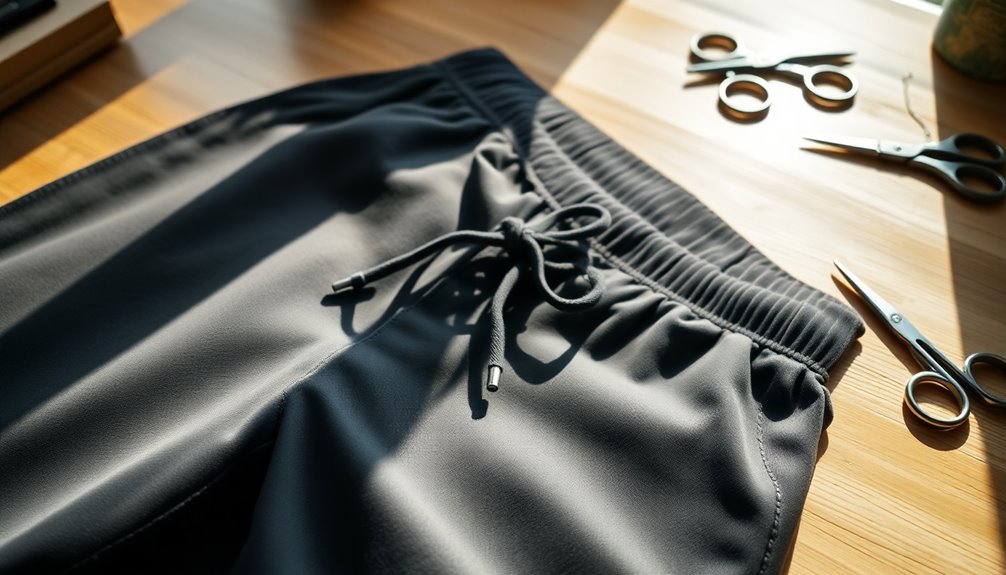
Understanding drawstring waistbands starts with recognizing their versatility and practicality in various garments. Whether you're working with shorts, pants, or skirts, a drawstring waistband enhances both functionality and design.
You can create these waistbands using a basic method or an elasticized option, allowing for a secure fit and ease of movement. Proper construction involves crafting a drawstring channel that accommodates the drawstring or elastic, ensuring it's wide enough to function smoothly.
Buttonholes or grommets serve as eyelets for the drawstring passing through, so placement and reinforcement with interfacing are essential for durability. For ideal appearance, the drawstring should be made from fabric strips, cord, or ribbon, ideally around 1 ¾ inches wide, ensuring safety for all wearers, especially children.
Materials Needed for Your Project
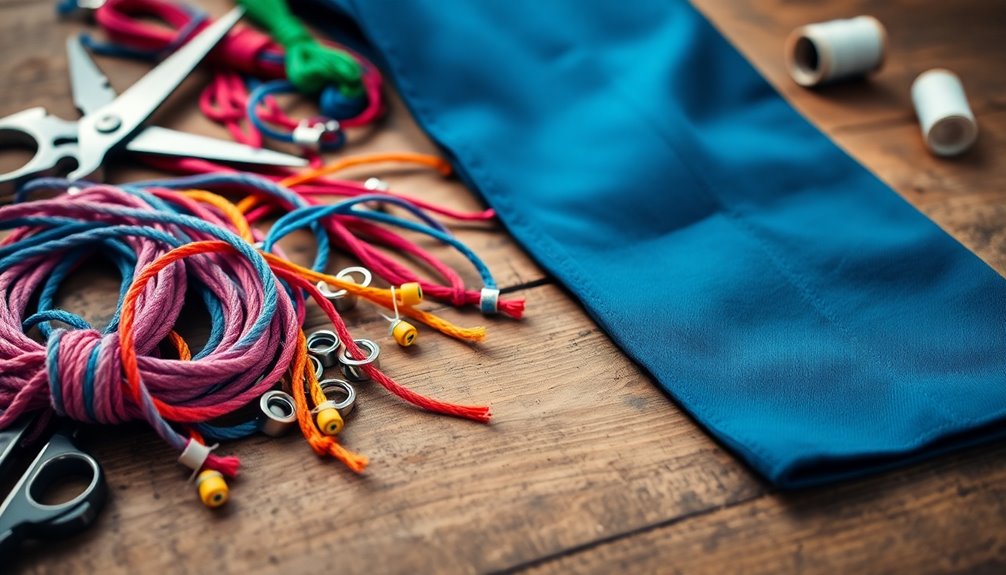
To get started on your drawstring pants, you'll need some essential fabric, like medium weight linen, and a few tools to make the process smoother.
Don't forget matching sewing thread and a safety pin for threading the drawstring.
If you want to add a personal touch, consider using contrasting materials for the drawstring to elevate your design.
Essential Fabric Choices
When choosing fabric for your drawstrings, prioritize sturdy materials like cotton or linen, as they not only enhance durability but also maintain their appearance under tension.
For a unique touch, consider using contrasting fabrics or ribbons that complement your pants' design. If you're in a rush, twill tape is an excellent alternative, offering ease of use and ready availability.
Don't forget to incorporate fusible interfacing in the buttonhole area to strengthen the fabric and prevent fraying. This guarantees a polished finish, especially when pulling the drawstring through the buttonhole.
Always account for seam allowance to ensure a secure fit around the elastic waistband, providing both functionality and style in your pants creation. Additionally, consider how a well-planned budget can help you allocate funds for high-quality materials and tools for your sewing project.
Required Tools Overview
Selecting the right fabric is just the beginning; having the proper tools guarantees your drawstring attachment goes smoothly.
First, gather your fabric and a small piece of fusible interfacing for added strength at the buttonhole area. You'll need a sewing machine with a buttonhole foot to create neat outlets for your drawstring tails.
Don't forget scissors, pins, a ruler to measure the width of your drawstring, and a chalk or fabric marker for marking. If you're using an elastic drawstring, make sure to have elastic material on hand.
A safety pin will help you thread the drawstring through the casing. With these tools, you're ready to pin and stitch your way to a secure attachment!
Optional Decorative Elements
Adding optional decorative elements can elevate your drawstring pants, making them not just functional but also stylish. Consider using contrasting ribbons or twill tape as your drawstring for a unique touch. You can also add beads or cordstops at the ends to enhance both function and aesthetics. Experiment with fabric scraps to create custom drawstrings that complement your pants. Decorative knots or tassels can provide additional grip and style. Finally, piping or bias tape along the drawstring channel can give your waistband a polished look.
| Material | Purpose | Notes |
|---|---|---|
| Ribbons/Twill Tape | Decorative Drawstring | Durable and stylish |
| Beads/Cordstops | Functional Aesthetic | Prevents slipping |
| Fabric Scraps | Customization | Unique colors/patterns |
| Piping/Bias Tape | Polished Finish | Adds detail to waistband |
Step-by-Step Guide to Creating the Casing
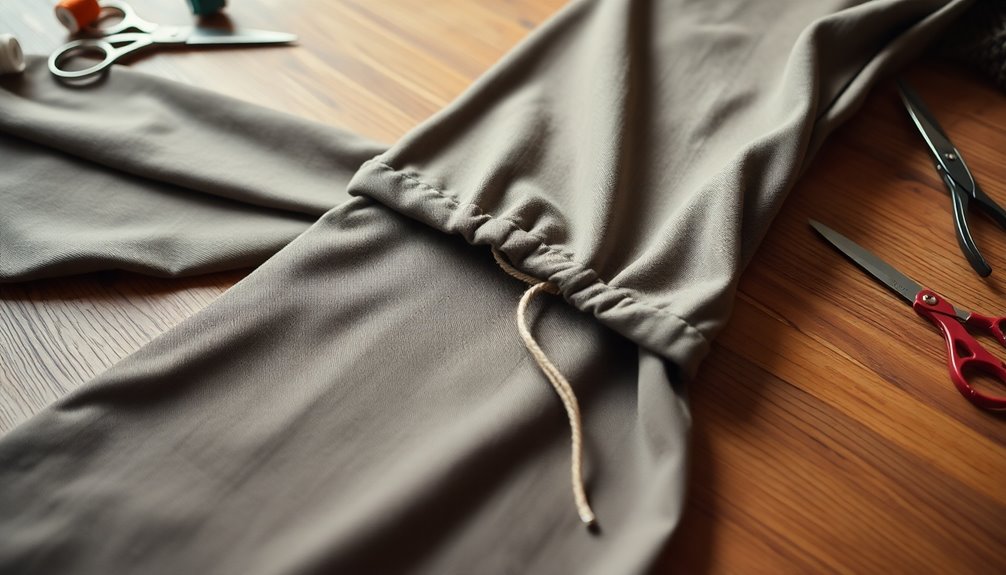
Creating the casing for your drawstring pants is a straightforward process that sets the foundation for a secure fit. Start by measuring and cutting your waistband channel fabric to twice your waist measurement, adding seam allowances for the right fit.
Fold and press the short ends to secure them neatly before attaching to the side seams of your pajama pants. When creating the casing, leave an opening for inserting the elastic or drawstring, ensuring it's wide enough for easy movement.
Stitch the lower edge of the drawstring channel about 3/8 inch from the raw edges to keep it in place while allowing for movement. After inserting the elastic, distribute gathers evenly and secure the ends with stitching for durability.
Techniques for Inserting the Drawstring
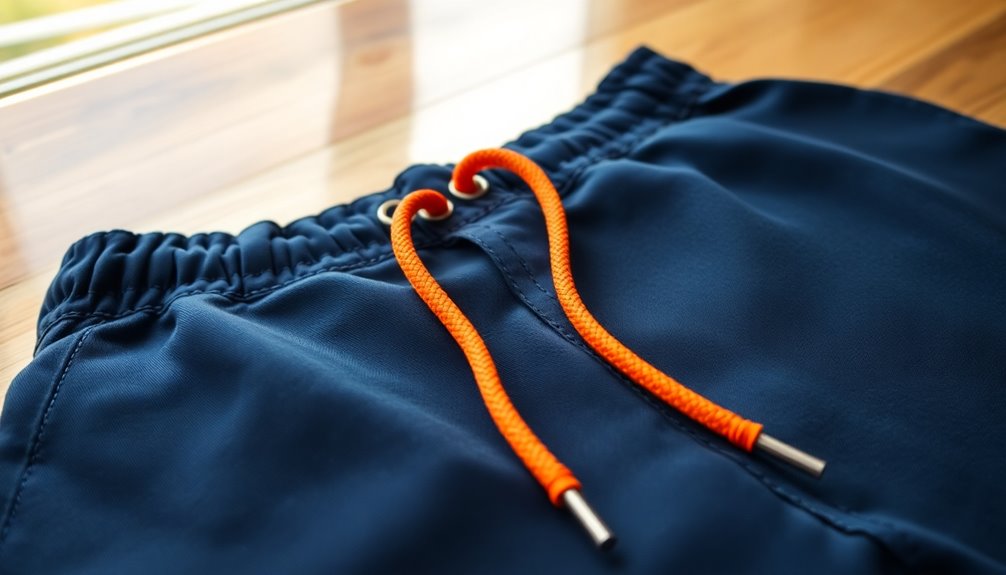
When it comes to inserting your drawstring, you have a couple of effective techniques to choose from.
The buttonhole or grommet method offers a sturdy option, while the safety pin insertion technique makes threading a breeze.
Each method has its advantages, so let's explore how to use them.
Buttonhole or Grommet Method
To securely insert a drawstring into your pants, you can choose between the buttonhole method and the grommet method, each offering distinct advantages.
The buttonhole method involves creating buttonholes reinforced with interfacing, measuring 1.3cm long, and placing them 2cm from the raw edges of the waistband. Make certain the size of the buttonhole matches your drawstring's width, allowing no more than 1/8 inch of extra space.
Alternatively, grommets provide a professional finish, especially for heavier fabrics. For grommet installation, gather your tools, including a setting anvil and mallet, and follow the six-step process for precise placement.
Both methods guarantee a secure fit, enhancing the functionality and durability of your pants.
Safety Pin Insertion Technique
Inserting a drawstring using a safety pin is a simple and effective technique that makes the process hassle-free.
Start by cutting a length of your drawstring, typically around 30 inches for adults, to accommodate your waistband measurement plus extra for tying. Attach a safety pin to one end of the drawstring; this will help guide it through the channel without snagging on raw edges.
Insert the safety pin at one end of the channel, gently pulling the drawstring to avoid twisting. As you reach the other end, verify the drawstring is evenly distributed.
Once fully inserted, carefully remove the safety pin and finish the ends of the drawstring to prevent fraying, securing it in one piece as needed.
Reinforcing and Finishing the Drawstring
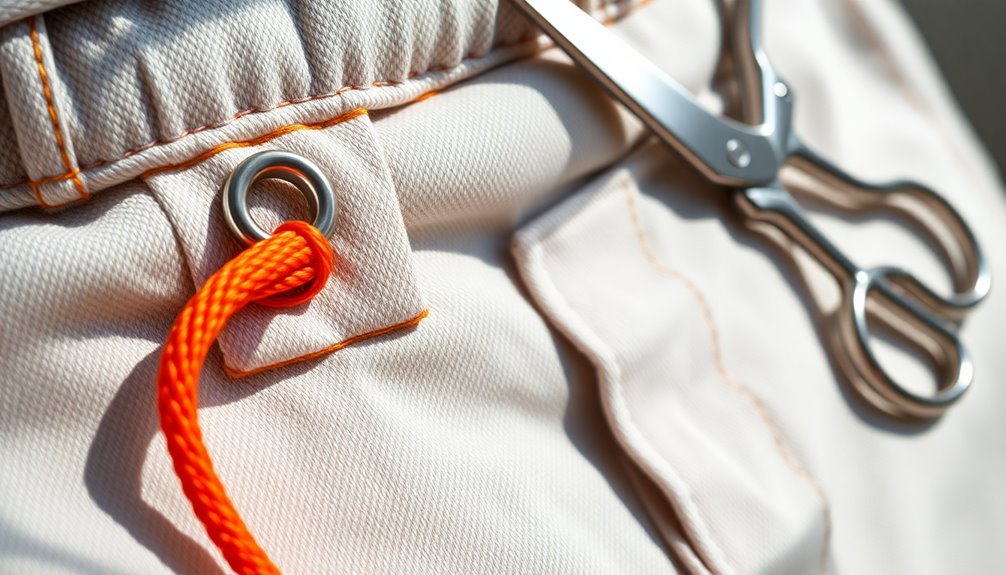
Reinforcing and finishing the drawstring is essential for durability and functionality. To guarantee your drawstring stays securely in place, stitch across the back or side seams of the waistband. This prevents it from slipping out when pulled.
If you're using buttonholes, reinforce the buttonhole area with interfacing for extra stability. Finish the ends of the drawstring by folding them under and stitching to avoid fraying, enhancing its durability during wear.
When inserting the drawstring, thread it evenly through the channel to prevent uneven gathers. For added aesthetics and functionality, consider adding cord stops or decorative beads to the ends. This not only keeps the drawstring from loosening unintentionally but also elevates the overall look of your pants.
Customization Ideas for Your Drawstring Waistband
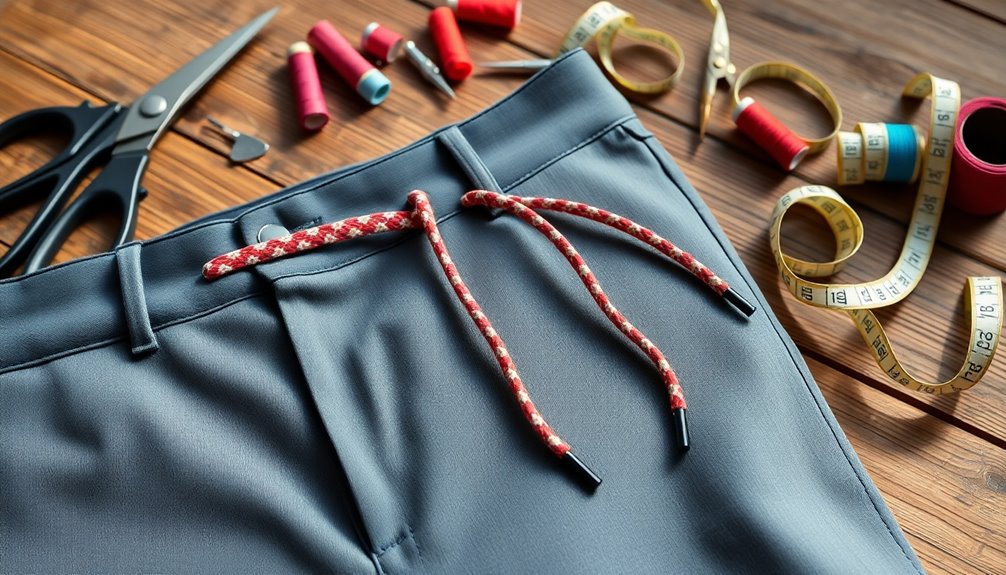
While customizing your drawstring waistband, you can easily add a personal touch that reflects your style. Consider using contrasting fabrics or ribbons for your drawstring to create a unique visual element. You might even choose printed or patterned fabric to make an eye-catching detail against solid-colored pants.
At the ends of the drawstring, incorporate details like beads or cordstops—not only do they enhance appearance, but they also prevent slipping. Experiment with different tie styles, such as bows or knots, to give your drawstring a tailored or casual look.
For a more feminine touch, add a buttonhole to the drawstring, or explore toggle clasps for an adjustable fit at the edge of the waistband. Additionally, consider gathering inspiration from interior design mood boards as they can help spark ideas for color and texture combinations that will enhance your overall customization.
Frequently Asked Questions
How to Attach a Drawstring to Pants?
To attach a drawstring to your pants, start by folding the waistband fabric down to create a casing.
Make sure it's wide enough for the drawstring to fit comfortably. Mark and sew buttonholes or use eyelets for threading.
Cut the drawstring to your waist measurement, adding extra for tying. Use a safety pin to guide it through the casing, then adjust it to your desired fit and secure the ends with knots.
How to Insert a Drawstring Without a Safety Pin?
To insert a drawstring without a safety pin, you can try a few clever methods.
First, use a large paper clip or binder clip to guide the string through the channel.
Next, thread a long piece of fabric or shoelace first, then attach the drawstring and pull it through.
Or, utilize a flexible straw to push the drawstring along.
Finally, a fabric tube turner can make the process smooth and easy.
How to Make a Drawstring Casing?
To make a drawstring casing, start by cutting a fabric strip that's twice the waistband's width and long enough for your fit.
Fold and press the short ends inward, then fold the bottom edge 1/4 inch towards the wrong side.
Pin the casing to the waistband, aligning raw edges, and stitch about 3/8 inch from the edge, leaving an opening.
Finally, fold down the casing, press it, and thread your drawstring through.
What to Use for Pants Drawstring?
When it comes to pants drawstrings, you'll find that choosing the right material can make all the difference—it's like selecting the perfect cherry for your sundae!
Opt for sturdy cord, ribbon, or fabric strips, ideally about 1 ¾ inches wide. For a stylish touch, consider contrasting colors or patterns.
Don't forget to measure the length based on your waist size, adding around 30 inches for tying. Beads or cordstops can add flair while keeping it secure!
Conclusion
Now that you're armed with the ultimate guide to securing a drawstring, you can strut around in pants that stay put instead of playing a game of "whoops, there goes my waistband!" Picture yourself confidently dodging a gust of wind or an unexpected dance move without fear of wardrobe malfunction. So grab your materials and channel your inner seamstress; it's time to conquer the world—one securely fastened drawstring at a time! Who knew pants could be so thrilling?
